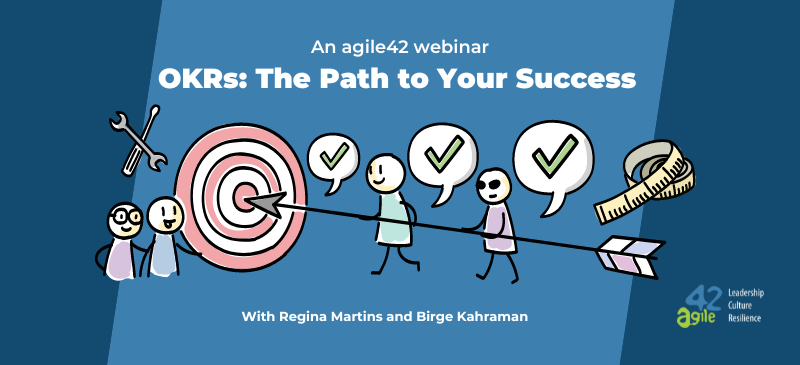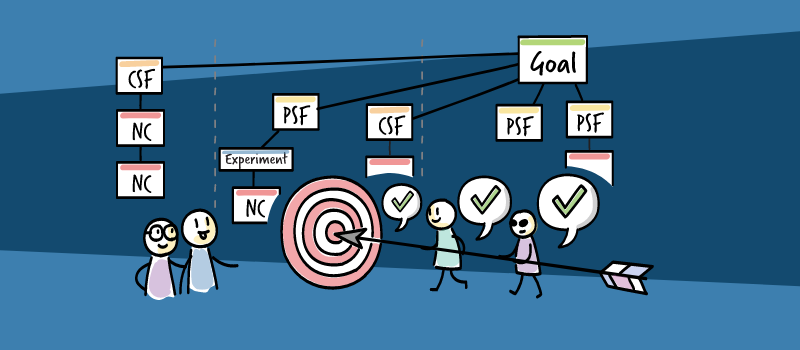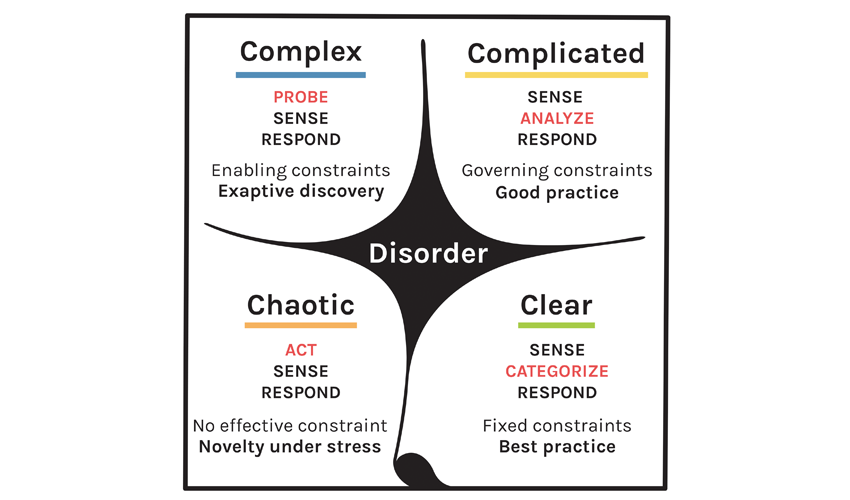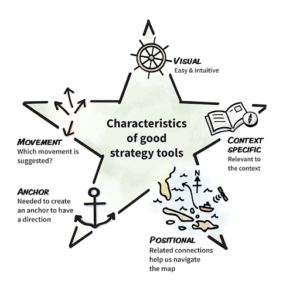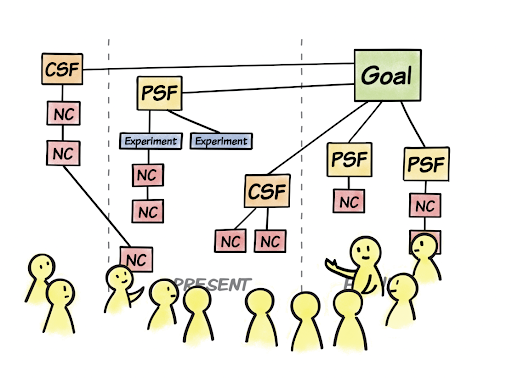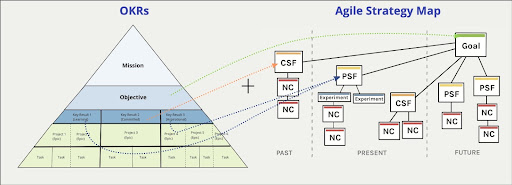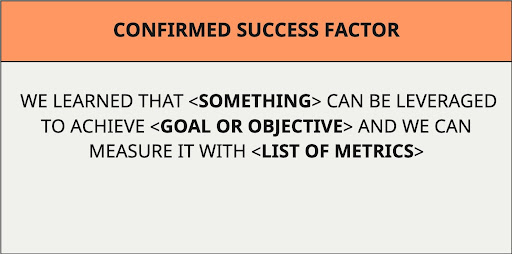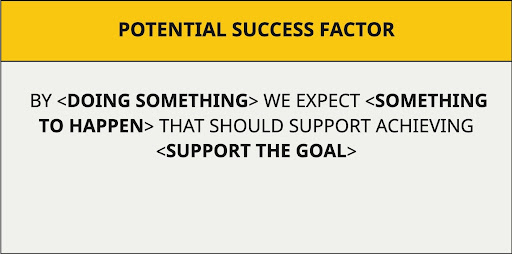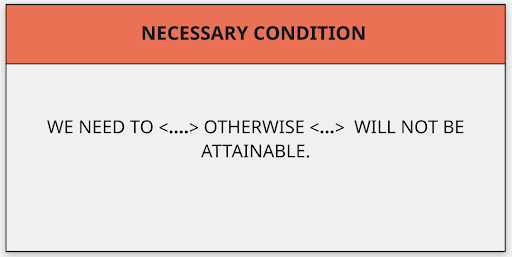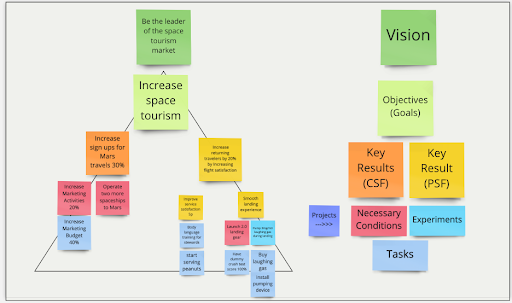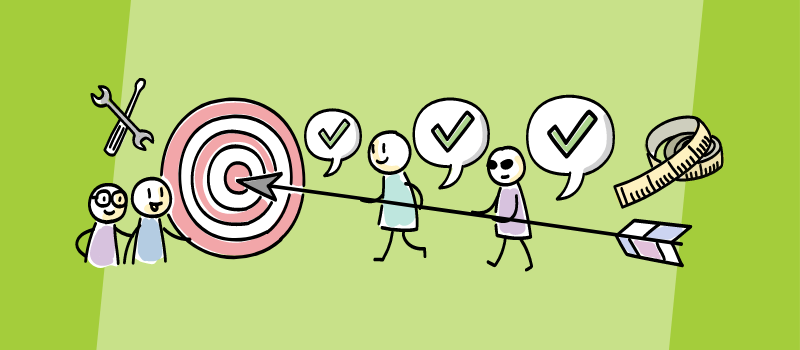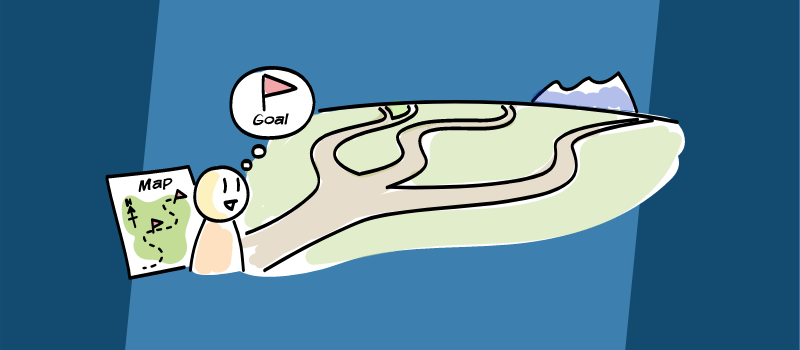Goals are what drives us, and creates a path to our success. Whether you’re a student, employee, or entrepreneur, you should have one big goal in mind that informs everything you want to achieve. But what do you do when you have identified the goal and know what you want to achieve? It’s time to break this goal into smaller parts and measurable outcomes, and Objectives and Key Results (OKR or OKRs) can be the perfect framework to achieve this.
Learn how to successfully implement OKRs in our virtual training: Get your OKR certification now
What are Objectives and Key Results?
OKR (or OKRs) stands for Objectives and Key Results, and it is a framework for setting a company, team, or individual’s goals. The value of OKRs is that they create transparency around the organization’s goals, which in turn helps employees feel more aligned and committed to achieving those goals.
OKRs put outcomes first because it’s a way of working purposefully, rather than focusing solely on metrics, which can be misleading. Just like the goal of the agile teams, OKRs work to deliver value rather than just checking items off a list.
Within OKRs, an Objective is what you want to achieve. Once you have an Objective, you need to define Key Results, which describe how you will reach that Objective. Key results are visible and measurable outcomes which bring success to you and your organisation. When working with OKRs, we refer to all the projects and tasks that will help you realize your Key Results as “Initiatives”.
John Doerr summarizes OKRs in his well-known book “Measure What Matters” as “Objectives and key results are like Yin and Yang of goal setting – principle and practice, vision and execution.”
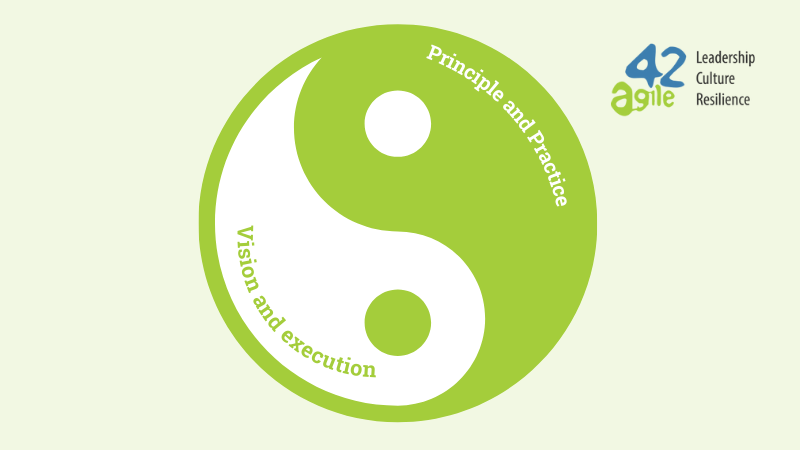
OKR Examples
Even once you know the definition of OKRs, it can be hard to fully grasp how they work without some examples.
Examples of Objectives
According to the definition in the book Measure What Matters by John Doerr, Objectives are defined as significant, concrete, action-oriented, and (ideally) inspirational.
Although there were no OKRs at that time, there is an excellent example of an Objective in John F. Kennedy’s speech to Congress in May 1961: “I believe that this Nation should commit itself to achieving the goal, before this decade is out, of landing a man on the Moon and returning him safely to Earth.“

More “formal” examples include the following:
- Decrease the carbon footprint of every household in Berlin
- Improve German fluency in daily conversations
- Make the company website more user-friendly
Examples of Key Results
Author Christina Wodtke said it best when she said, “I know I’ve got the right Key Results when you are also a little scared you can’t make them.”
Key Results represent the “how” part of your journey. They need to be SMART (specific, measurable, actionable, realistic, and timebound) as well as ambitious and verifiable. You should have a direct influence on the results and be able to quantify them.
If we continue with one of the examples of an Objective from above, the related KRs could include the following:
- Make the company website more user-friendly.
- KR1: Increase loading speed by 20%
- KR2: Shorten purchase flow from 6 steps to 3
- KR3: Increase the NPS from 65 to 75
- KR4: Grow the recurring visit 10% for Q4
Why do we need Objectives and Key Results?
The OKR process brings your ideas to life by helping you focus on what matters. Many teams and organizations suffer because of distractions. Distractions are all the seemingly good ideas that arise when working towards a goal, but don’t actually help to achieve that goal. They just overload you or take your valuable time without bringing any additional value.
In addition to focusing your efforts, OKRs are also great for creating alignment, clarity, and achievable commitments, as well as tracking progress.
The OKR framework is more than a goal-setting framework; it’s an essential part of the drive towards continuous improvement. It requires the involvement of every individual and involves every aspect of the business; from strategy to processes, behavioral changes, and even individual development.
How to write Objectives and Key Results
All levels of the organization and every department must be involved with setting OKRs, which need to serve the same company vision and strategy. Ideally, one individual (or team) should only commit to one Objective and at most five Key Results.
This process will require making some bold decisions initially, especially when it comes to cleaning up all the unnecessary tasks and processes your company is accustomed to doing. It’s never easy to say “goodbye” and eliminate the hard work you have done before. However, if this work is no longer aligned with your OKRs, you need to be brave and focus on what matters.
Step one: Define your business priorities
To get started with OKRs, you need to start defining your long-term business priorities. You don’t need to have your entire future mapped out right away: three to four items for the next 12-month period is a good start. These priorities will form your organizational OKRs. This first step is at the strategic level and helps to define your direction for the year.
Step two: Break your annual goals down into smaller goals
Once your annual, high-level strategic OKRs are in place, you can start breaking them down to your tactical OKRs, which brings you one level down, to the operational level. These are your quarterly OKRs, and they will help you focus on the upcoming 90 days.
Step three: Ask your team how they can contribute
With your organizational and tactical goals defined, it’s time to bring the team on board. Engage your team, take a bottom-up approach, and find out from your team members how they can best contribute to achieving those OKRs. It is critical to involve your team at this stage, as these are the people who will be bringing the goals to life. The aim of this step is to define your Key Results.
Step four: Plan projects and initiatives
Finally, teams can come together and start to plan the projects or initiatives they want to do, in order to fulfill their OKRs.
Step five: Follow up
It’s essential to follow up on the OKR progress. Weekly or biweekly meetings are ideal to talk about the process, progress, and flow. They create transparency and accountability, and solve impediments.
Don’t be discouraged if you don’t successfully meet all your OKR results at the end of the quarter. Companies can rarely achieve their OKRs in their very first cycle. OKRs will mature and improve iteratively. Never forget that “perfection is the enemy of the good”: trying to perfect everything early on can get in the way of long-term improvement.
The pyramid of clarity
It’s a challenge to create a balance between high-level, long-term goals and short-term plans. Asana’s “pyramid of clarity” is the way to see how things fit together. You can determine how every individual daily task fits into the overall company strategy and mission. When you use the pyramid of clarity, you provide responsibility, strategy, and purpose to your organization. It also assists in structuring your OKRs in nested OKRs and cadences.
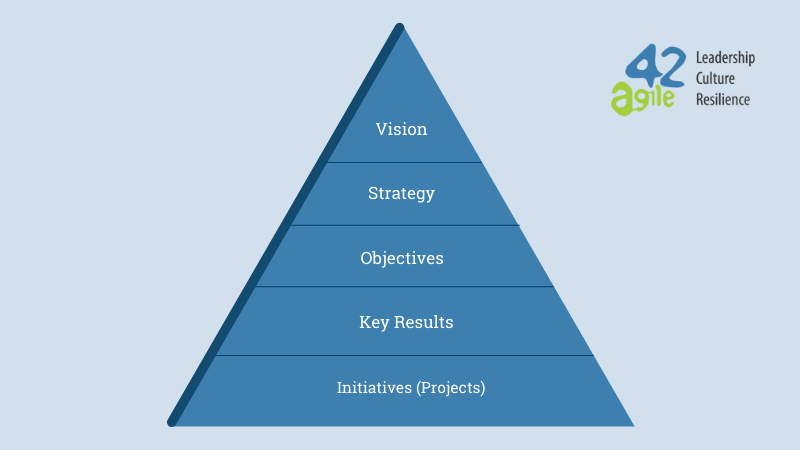
Cascading vs Aligning OKRs
Cascading OKRs is the process of aligning objectives and key results from higher levels of the organization to lower levels. This ensures that everyone in the organization is working towards the same goals and that the objectives at every level contribute to the achievement of the organization’s strategic objectives.
To cascade OKRs effectively, organizations should start by defining their top-level objectives and key results. These should be specific, measurable, and aligned with the organization’s mission and vision. The top-level OKRs should then be communicated to the rest of the organization, along with the rationale behind them, to gain buy-in and commitment.
Next, each department or team should develop their own set of OKRs based on the top-level OKRs. These departmental or team-level OKRs should be specific and measurable and should contribute to the achievement of the top-level OKRs.
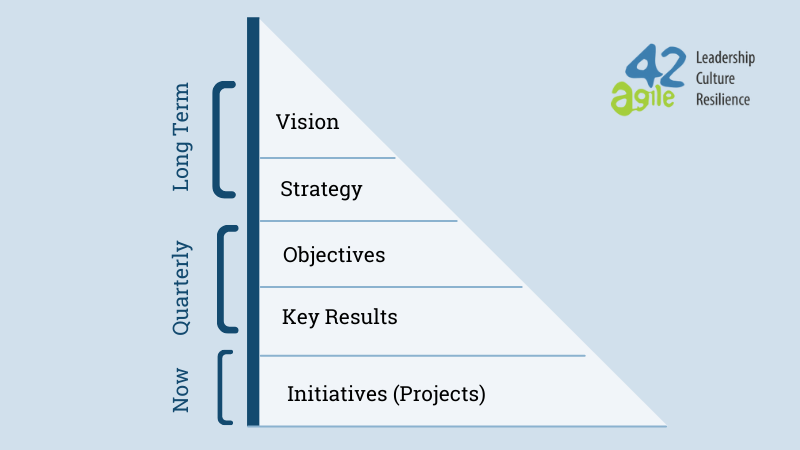
Aligning OKRs refers to the process of ensuring that objectives and key results across the organization are aligned with the organization’s overall strategy and mission. This makes sure that everyone in the organization is working towards the same goals and that the objectives at every level contribute to the achievement of the organization’s strategic objectives, however it doesn’t mandate any hierarchical structure. Aligning OKRs allows for more flexibility and autonomy, and it keeps everyone on the same page. This is the healthy way of committing to realistic OKRs, because it gives an opportunity to everyone to be involved.
Between cascading and aligning OKRs, organizations should choose the approach that best fits their goals and needs. However, in the wrong hands, cascading OKRs could turn quickly to a hierarchical/top-down commanding tool and take away the team’s autonomy. Management should never use OKRs as a control mechanism. They will work at best for the empowered teams, who decide how to reach the desired outcomes. As an organization, you should be able to balance the objects with bidirectional goal setting.
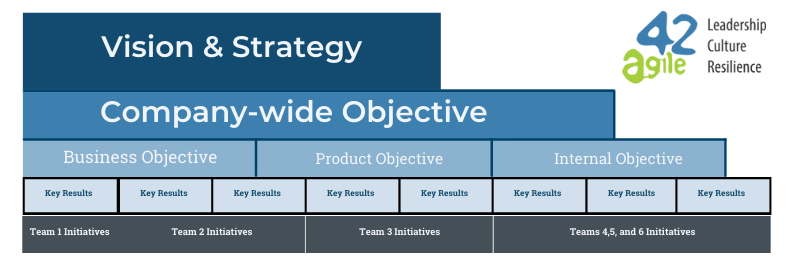
Measuring progress through the OKR cycle
OKRs are a tool for setting and achieving goals. That means you have to take an organized, analytical, and initiative-oriented approach to writing and reviewing your OKRs. A great way to do this is by conducting weekly or biweekly meetings to discuss your OKR progress for the week.
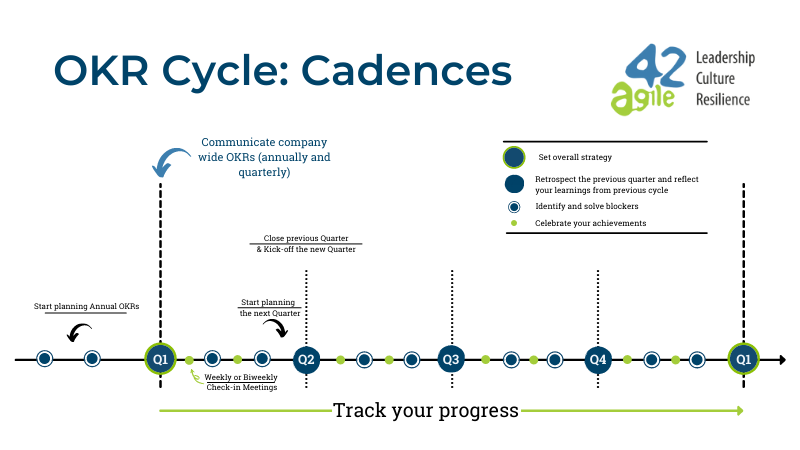
How regularly should you review OKRs?
Checking and adjusting different levels of OKRs requires different rhythms: your big annual goals might require an annual check-in, for instance, while operational OKRs require weekly progress meetings. This is a great time to discuss your individual and collective progress toward your company’s stated objectives. During those meetings, you also should check your confidence towards OKRs and go over the week’s priorities.
It can be helpful to sync this cadence with your Scrum rituals. The initiatives can be divided into sprint goals and during every review, it’s possible to see the progress. Retrospective meetings are a great way to improve your processes and collaboration.
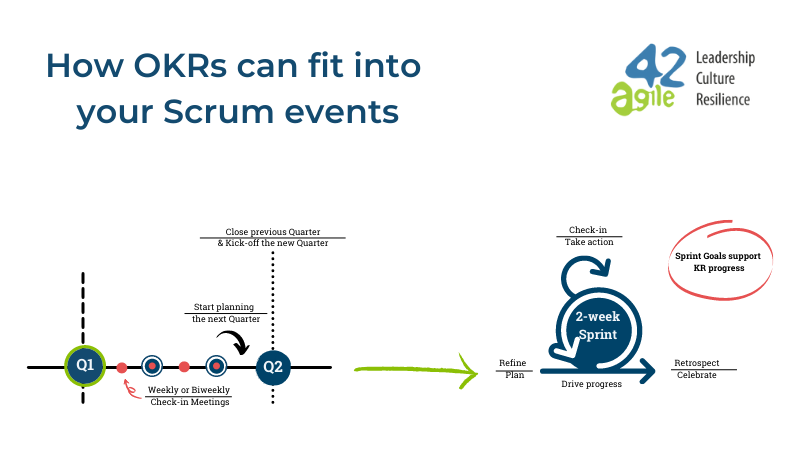
OKRs vs KPIs: What’s the difference?
OKRs are not designed to keep track of every single thing going on in the company. They are stripped back to the most important goals, which will have a significant impact when you achieve those targets. KPIs, or Key Performance Indicators, are more focused on the day-to-day, business-as-usual aspects of the company. A KPI is a critical indicator of progress toward an intended result. You may measure many different things within your business, but only a few of them are crucial for your organization. Those crucial indicators are your KPIs.
A great way to understand this is with the analogy of a car trip. The Objectives are your destination, and Key Results are the road towards this destination. KPIs, meanwhile, are your car’s dashboard, showing that your engine is running correctly. Just like the numbers in your car’s dashboard, your overall business performance, risks, and all the other activities are measured by KPIs. KPIs are direct indicators that immediately tell you if something is working or not.
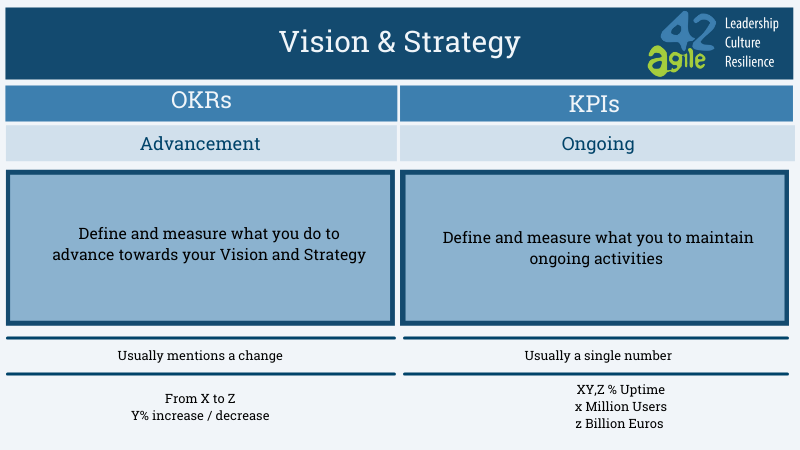
Is a KPI and a Key Result the same thing?
KPIs and KRs are not the same thing. However, in some cases, a KPI can become a Key Result. For this, it has to fulfil all of the following criteria:
- It needs to have a base-line, target value, time-frame, and an owner
- It has to have the purpose of advancing you towards your vision and strategy.
For example, revenue can be one of your KPIs. If you measure your baseline, you may set an ambitious but achievable target for a three-month time-box. If your tactical Objective is”drive worldwide sales growth,” you can add your revenue KPI as a KR: “Increase the Revenue from $3 million to $4 million in the fourth quarter.”
Health metrics can add to your success
Health Metrics are all the other things clustered together that you need to keep an eye on to keep business going. They can vary from the Team Mood to Customer Satisfaction or Code Health. You may use traffic lights or any other metric management best practice. Just ensure that you don’t overcrowd your radar with unnecessary information. It’s also essential to have up-to-date data.
Company culture plays a significant role in success of OKRs
Adopting OKRs usually requires more than changing the project management approach. It’s a new way of working. A safe company culture is essential, wherein people are not afraid to set ambitious stretch goals, fail, and learn. As in any cultural transformation, change will not happen immediately. But it is possible to transform the company’s dynamics in a few months, if you focus on aligning and engaging the team. To achieve that, your mission and committed goals need to come first, and the team should feel comfortable speaking up and having disagreements. It’s also important to make it okay to deliver the bad news and impediments without fear.
Conclusion
Consistency and focus are two big keys to achieving your goals, whether they’re long-term or short-term. Over time, your goals and accomplishments will add up and become the building blocks of your success. The OKR technique will increase your team’s capabilities and focus on the right things. It will change your company culture in a more open and collaborative way. All the self-reflections along your journey will make you more resilient and adaptive. Last but not least, don’t forget to celebrate your achievements, learn from your failures, and trust your team members.
If you want to learn more about the OKRs, we highly recommend reading Measure What Matters by John Doerr and Radical Focus by Christina Wodtke.
Need help with your goal-setting?
Goal-setting is one of the most important predictors of success, but it’s also one of the hardest to get right. Sign up to the agile42 Corporate Learning Program and we can help you set your team up for success, with custom training and coaching based on your particular business needs. Contact us for more info.

